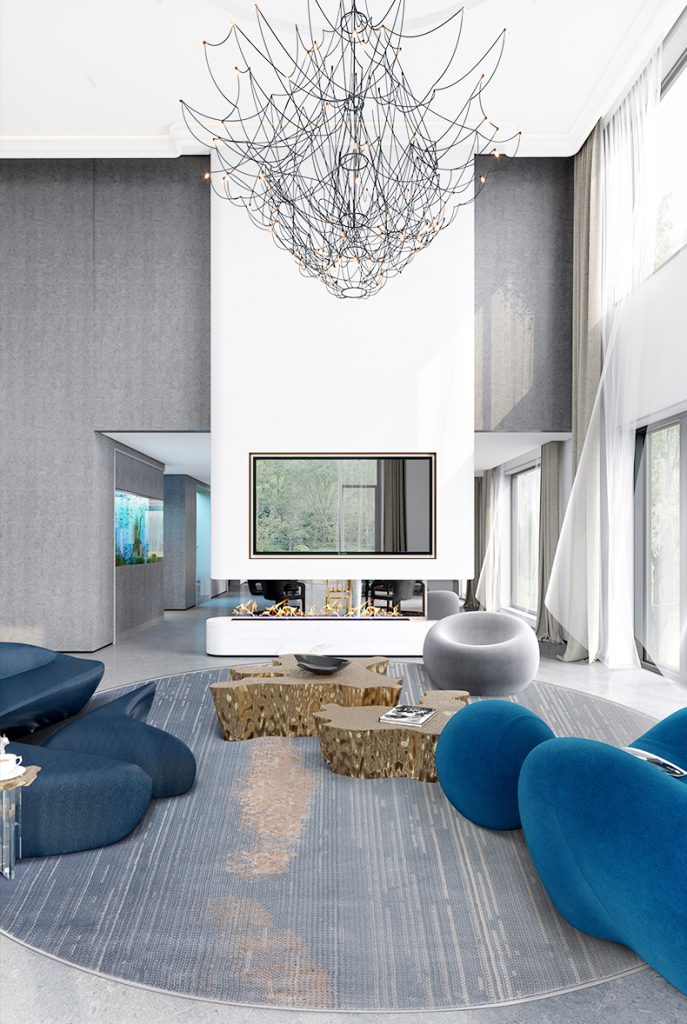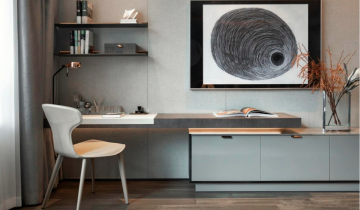Small living rooms have their own set of concerns due to their restricted size, but larger living rooms have their own set of issues. Larger rooms are great for entertaining, but they aren’t as cozy or functional for day-to-day life. These ideas might help you make your room feel balanced and comfortable, whether you live in a loft, have a living room with unusually high ceilings, or simply have a lot of space to fill.
Set Up Zones in your Space
In a tiny space, you’ll probably only have enough place for one conversation area and no other furniture groups. Large rooms may be used for much more than just a large sitting area, but you may need to get creative in order to make the most of the space you have. Determine whether the room needs a discussion zone (or two or three! ), a media zone, a writing desk, a console or a game table, a dining space, or a reading area.
You can utilize ceiling beams, partial walls, or pillars to visually separate a room in semi-permanent ways, or you can use area rugs, curtains, wallpaper, and furniture placement to help create visually intimate sections inside the larger room for flexibility. You can use a daybed as a room divider. In a really large living room, you may wish to create two full seating areas. Mark the separation while keeping the flow between the two zones with furniture you can easily see over: a daybed, bench, or chaise is a good option.
Round out a big seating plan
Create a greater punch by bringing together your sofa and chairs and a round ottoman or table rather than just two chairs. Chairs are less visually divisive in a room than a sofa so they can create a pleasing flow and conversation area in large spaces, small rooms or awkward areas with challenging traffic patterns. Anytime you can use several of anything like double footstools, two lamps or sets of chairs, the impact will be greater!
Lighting Strategies
Lighting can make a big difference in how a space seems, no matter how big it is. Fortunately, because a large space frequently has more windows, lighting is less of an issue during the day. However, at night, shadows and dark nooks can make anyone feel nervous. If you only have one central ceiling light, you’ll probably want to supplement it with lamps..
Avoid ‘hugging’ the wall too much
A huge room with the sofa pushed back against one wall and the chairs on the opposite side of the room against the other wall, leaving too much open space in the centre, strikes me as amusing. If you have to shout to have a conversation with someone sitting across the room, your furniture is most certainly too far apart.
With a larger space, you can draw seats away from the walls to create a cozier conversation area around a focal point such as a fireplace. Don’t be afraid of blank walls; they can be used for art, buffets and consoles, seats and bookcases, or additional discussion places where the furniture can be pushed closer together.
Make use of color
Color and pattern can be utilized to break up large swaths of wall in a living room or to reduce the height of a tall wall to a more comfortable level. Paint varied shades of neutrals or colors above and below the molding to create wainscoting. If your room has a high ceiling, you might want to try a simple approach to warm it up. If you paint the ceiling a shade or two darker than the walls (or use paneling! ), the ceiling will appear lower and the room will feel more intimate and inviting.
Create an intimate spot for two
Don’t forget to consider how you’ll use the space. It’s easy to forget that we’re not always throwing parties, especially with huge living spaces that are well-suited to entertaining large crowds. Try tucking a small card table against a bare wall along with a pair of elegant chairs. You can use this space for reading, or chatting.
Make a reading nook or a second seating area
Even after filling up a primary sitting arrangement in a large living room, there will most certainly be an odd corner that remains unfilled. If you put as much attention into this corner as you do the “primary” seating area, it just might become your new favorite hangout zone.
Here are some suggestions for your unused space: Create a small chat group with a pair of slipper chairs or a mini library with floor-to-ceiling bookcases and a single fantastic armchair by adding a window seat.
Anchor the Room

In a large space there tends to be more furniture and accessories, which can feel a bit haphazard. One way to tie a large room of furniture together and unify your style is through repetition. Repeating fabric patterns or colors on chairs or throw pillows will help carry your eye around the room and feel visually more pleasing.
Layers up the make the space more cozy
If your room feels cold, sound echoes or if the vibe is cozy enough, it might not be the size of the room but instead you just might need more layers. Add area rugs (you can even layer two rugs together for even more texture), hang curtains, add baskets for more texture and sound absorption and accessories to help soften the spaces. Softer spaces feel much cozier and inviting so be sure you have plenty of upholstered pieces, too!
Theory of Living offers a range of carefully curated accessories and furniture goods to bring you quality modern interior collection goods for you to style your homes and spaces with it.
Visit our Website and Tokopedia Store for more of our home accessories and furniture.
Source: theinspiredroom.net, forbes.com, houzz.com, unsplash.com




 No products in the cart.
No products in the cart.